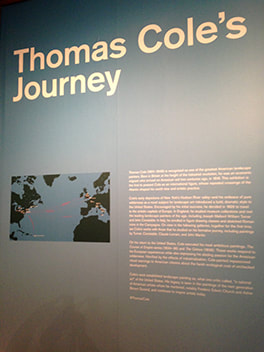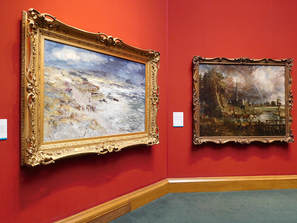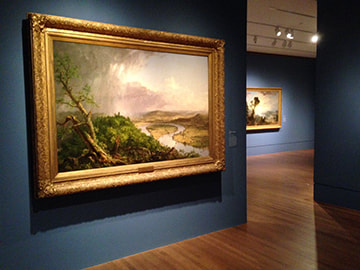 Thomas Cole and the Hudson River School of landscape painting are distinctly American, depicting the magnificent scenery of the United States in the first part of the 19th century. In “Thomas Cole's Journey Atlantic Crossings,” as exhibition at the Metropolitan Museum of Art, we wee how both Cole's art and his thinking was shaped by his experiences in Europe. Cole was born in northwest England in 1801. The Industrial Revolution was beginning and during his boyhood, Cole witnessed the transformation from a rural society to an industrial one with nature giving way to factories and crowded cities. For a time, the young Cole worked in the new mills designing patterns for textiles. However, in 1818, facing financial hardship in England, Cole's father moved the family to the United States. As a young man Thomas Cole traveled around Pennsylvania and Ohio painting portraits. Although he was largely self-taught, Cole achieved some success, exhibiting his work at the Philadelphia Academy. In 1825, Cole fell in love, not with a person but with the beauty of the undeveloped Catskill region of New York. He painted what he saw and although landscape painting was not a well-established genre in the young United States, his paintings drew attention and he was made a member of the National Academy. Cole decided that in order to develop as an artist he had to return to Europe. There he could study past masters and meet leading contemporary artists. His first stop was England. There was a long tradition of landscape painting in England. In addition, two contemporary painters were taking this genre in new directions. J. M. W. Turner was incorporating bold colors and unrestrained brush work to produce pieces that were significantly different than traditional landscape painting. His work has been described as a forerunner of modern art. Cole was impressed with some of Turner's paintings but was uncomfortable with both Turner's unkempt appearance and the wildness of his approach to art. Cole was much more comfortable with John Constable, with whom he became friends. Constable's large finished canvases were more traditional and constrained than Turner's works. However, the oil sketches that he made in preparation for his finished works have a great freedom of brush work and spontaneity. In addition to Cole's work, the exhibit displays some of the works by Turner and Constable that Cole saw or could have seen during his journey. Particularly interesting are the numerous Constable oil sketches. Cole did not just stay in England but traveled into France and Italy. In Italy, he enrolled in classes. made copies of works by Renaissance masters and made oil sketches of the Italian countryside and Roman ruins. As he had hoped, Cole's journey to Europe enhanced his artistic skills. In addition, he met many wealthy Americans while traveling abroad and received a number of commissions. As a result, his reputation also grew. Returning to the U.S., Cole had a successful exhibition of his European paintings in New York City. More commissions followed. He established a studio in the Catskills. Other artists also came to study under Cole and he shaped an artistic movement. Having seen the results of unfettered industrialization in England, Cole became very concerned that President Andrew Jackson was leading the country in the wrong direction. The beautiful American wilderness was in danger from unrestrained development. Cole took up his brushes to warn of the consequences. Thus, while Cole's works may appear to be just paintings of beautiful scenes, they are actually political pictures. Cole was saying that all this will be lost if you continue with such policies. It is still a timely message. In this vein, the exhibit presents a series known as “The Course of Empire.” In the various canvases, Cole shows the same landscape first in its wild state and then progressively through development into a classical city and eventually to the final ruin of civilization. Perhaps more more subtlety, Cole expresses much the same message in“The Oxbow,” which shows a pristine river valley about to be engulfed by a massive storm. Cole's works transcend their political message. He had mastered traditional landscape painting and used it to portray magnificent scenes. Furthermore, his ability to compose a scene so as to make it speak to a wide audience cannot be denied.  “Constable and McTaggart: A Meeting of Two Masterpieces” at the National Gallery of Scotland is a small exhibit that provides insight into the evolution of art. John Constable was one of the great English landscapes. Born in 1776 into a wealthy merchant family, Constable intially struggled for success but by the end of his life, he had become a member of the Royal Academy and had achieved fame in Britain and in Europe. The paintings that established Constable's reputation during his lifetime are polished works that follow in the tradition of the old masters. His inspirations included works by Claude Lorrain and Peter Paul Ruebens. However, distinguishing Constable's works from traditional landscapes was considerable emotion. “Painting is but another work for feeling.” Some of Constable's most successful works were monumental paintings that he called “six footers.” These monumental works have impact not just because of their size but because of the aforementioned emotion that Constable put into his works. His last six-footer “Salisbury Cathedral From the Meadow” (1831) is on display at the exhibit. The cathedral is seen in the distance with dark storm clouds surrounding it. While Constable disdained the traditional practice of altering nature to create an ideal landscape, he has added a rainbow that is not in the preparatory studies for the painting. Hope for the future after the passing storm. In preparation for the paintings he exhibited, Constable would do oil sketches. These paintings are much more impressionistic with bold expressive strokes. They were never meant for sale or public display but rather were meant to be references, memorializing a particular scene or a cloud formation etc., for use in a future more polished work. As a result, the oil sketches were not exhibited until after Constable's death. The exhibit contains several of these oil sketches. William McTaggart was also a landscape painter. He is sometimes called the “Scottish Impressionist.” Born in 1835, McTaggart was a generation or so after Constable. Nonetheless, he was greatly inspired by Constable. Constable's influence on McTaggart can clearly be seen in the exhibit. For example, McTaggart's “The Storm” is a monumental work of the size of Constable's “Salisbury Cathedral.” However, the style of the work is similar to the style of Constable's oil sketches with loose expressive brush strokes and impressionistic vagueness. Like Constable's, McTaggart's works are full of emotion. The exhibit thus shows how an idea developed as a tool by an artist in one generation can be carried forward in a later generation to become the final end product. |
AuthorRich Wagner is a writer, photographer and artist. Archives
November 2018
Categories
All
|

 RSS Feed
RSS Feed